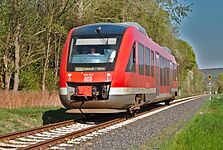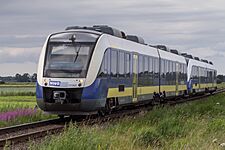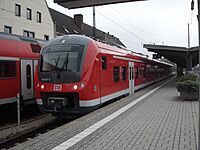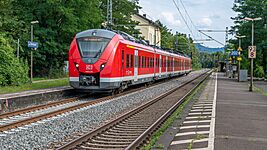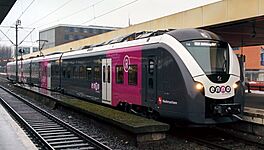Alstom Coradia facts for kids
Quick facts for kids Alstom Coradia |
|
|---|---|
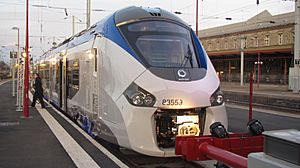
A Coradia Polyvalent train built by Alstom.
|
|
| Manufacturer | Alstom |
| Specifications | |
| Prime mover(s) | 4 6 MAN D2676LE62X |
| Track gauge | 1,435 mm (4 ft 8 1⁄2 in) standard gauge |
The Alstom Coradia is a group of modern trains made by a company called Alstom. These trains are used for travel between cities and within regions. You can find different types of Coradia trains running in Europe, North America, and Africa. They are designed to be comfortable and efficient for passengers.
Contents
Train Design and Features
The Coradia trains are built to be high-performance. They come in different setups to meet what train companies need. Some Coradia trains run on diesel fuel (called DMUs), while others use electricity (called EMUs). There's even a special double-decker version called the Coradia Duplex.
These trains use a special system that helps them speed up smoothly and save energy. They also have a system that helps save power when the train slows down. Coradia trains can be fitted with different communication and safety systems. This includes systems that help control the train automatically.
Comfort for Passengers
The Coradia trains are made to be very comfortable for people riding them. Inside, they have nice lighting and places to store luggage. There are also walls that separate the seating areas from the entrance.
Each seat can have power outlets for charging devices, its own light, and even audio or video systems. Train companies can choose how the seats are arranged. It's easy to change the inside of the train because parts fit into special slots. Some trains might even have vending machines, ticket machines, or internet access. Special features for passengers with disabilities can also be added.
Different Coradia Trains
The Coradia family includes several types of regional trains. These are the Coradia Duplex, Coradia Lint, Coradia Continental, Coradia Polyvalent, and Coradia Nordic. Alstom also made the Coradia Meridian especially for train companies in Italy.
Coradia Continental
The Coradia Continental is an electric train. It can have three, four, five, or six carriages. Up to four of these train sets can be linked together during busy times. Its power system is on the roof, which makes more space inside for passengers. This train is used in Germany and other European countries. It fits standard train tracks and platforms.
Coradia Duplex
The Coradia Duplex is a double-decker electric train. It can have two to seven carriages. Up to four train sets can be connected, making a very long train of 12 carriages. One version is used in France and Luxembourg. Another version is used in Sweden.
Coradia Nordic
The Coradia Nordic is a wider train. It was made for the larger tracks often used in Northern Europe. It comes as four, five, or six-carriage electric trains. This train can work in very cold weather, down to -35°C. Its power equipment is also on the roof to make more room for passengers.
Coradia LINT
The Coradia LINT is a light train that runs on diesel. It's similar to other popular regional trains. It can have one, two, or three carriages. Up to three of these train sets can be connected. The engine is under the train, which helps create more space inside. This design also meets modern environmental rules. It is used by many railways in Germany, the Netherlands, and Denmark.
Coradia Polyvalent
The Coradia Polyvalent is one of the newest Coradia trains. It can travel up to 160 kilometers per hour (about 100 miles per hour). It can run on electricity or use both electricity and diesel. There's also a version that can cross borders and work on different power systems. The train's low floor makes it easy for passengers to get on and off. Special parts help reduce shaking and noise inside the train.
Coradia MAX
The Coradia MAX trains are a mix of single and double-decker carriages. These trains are used by DB Regio AG in Germany. They operate between cities like Hamburg, Rostock, and Lubeck.
Train Operators Around the World
Coradia trains are used by many different train companies in various countries.
Europe
Denmark
Alstom Coradia LINT diesel trains are used for local services in Denmark. In June 2021, Alstom received a large order from the Danish state railway company, DSB. This order was for 100 Coradia Stream IC5 electric trains. DSB plans to buy a total of 150 of these trains. Delivery was originally planned for 2024 but is now expected to start in 2027. These trains will have 5 cars and 300 seats.
Finland
The VR Class Sm4 Coradia trains are used for regional travel from Helsinki to several other cities like Hanko and Tampere.
France
In October 2009, Alstom received a big order for 100 Coradia Polyvalent trains from the French national railway operator SNCF. More orders followed in 2010. In May 2014, the Régiolis train, which is a Coradia Polyvalent, was introduced in Paris. Many of these trains have been ordered by different regions in France. SNCF also ordered 14 hydrogen trains in 2021.
Germany
The Coradia Continental trains are used by several operators in Germany. They were first introduced in 2002. Companies like Hamburger Hochbahn (for agilis), DB Regio, Metronom, and Hessische Landesbahn (HLB) use them. In December 2020, S-Bahn Nuremberg started using Coradia Continental trains on some of its lines. Some of these trains needed special equipment to run on high-speed lines.
The Coradia LINT trains are also used in Germany. They are known as DB class 640 and DB class 648. Many orders for these trains have been placed by various German operators over the years. For example, in May 2014, Alstom delivered 24 updated Lints to Lower Saxony. In April 2014, a contract for 29 Coradia Continental electric trains was signed for Central Saxony.
Italy
In September 2012, Alstom received an order for ten more Coradia Meridian regional trains from Ferrovie Nord Milano (FNM). By 2013, 14 trains had been delivered. Ferrovie dello Stato ordered another 70 Coradia Meridians in November 2012. The Coradia trains are used by Trenord for regional and airport services.
Coradia Stream trains are operated by several Italian companies, including Trenitalia and Trenord.
Netherlands
The Alstom Coradia LINT trains were used by Keolis for regional transport. Arriva still uses LINT trains on the Zutphen-Hengelo-Oldenzaal route.
Nederlandse Spoorwegen (NS) introduced its new NS Intercity Nieuwe Generatie trains, which are based on the Alstom Coradia Stream, in April 2023. By 2025, these new trains have mostly replaced older train sets. They will also replace the trains used for services between Amsterdam and Brussels.
Norway
In January 2022, Norske tog signed a deal to buy 30 new Coradia Nordic trains from Alstom. They also have the option to buy 170 more. These trains are for commuter services in the Oslo area. They will have six cars and a top speed of 160 km/h. Production started in 2023. The first trains are expected in Norway for testing in 2026, and will begin service later that year. An additional order for 25 more trains was announced in February 2023. Some of these will be designed for regional service with more seats and a top speed of 200 km/h.
Romania
In March 2022, the Romanian Railway Reform Authority (ARF) ordered 20 Coradia Stream trains. This order also included 15 years of maintenance. These trains will be used by CFR Calatori and other private operators. The order has an option for 17 more trains, which was activated in September 2022. The Coradia Stream model ordered is 160 meters long and can carry 352 passengers. They are equipped with modern safety systems.
Sweden
The Coradia Nordic trains are used for commuter services in and around Stockholm by Storstockholms Lokaltrafik (known as X60). In June 2012, Storstockholms Lokaltrafik ordered 46 Coradia Nordic trains. This brought the total number of Nordic trains ordered to 129. More contracts have been signed for other Swedish operators, especially Skånetrafiken. In February 2015, Skånetrafiken ordered 25 Coradia Nordics. Both the Continental and Nordic types were first called Coradia Lirex.
A version of the Coradia Duplex, the SJ X40, is used by SJ AB. It was originally meant for regional travel around Mälaren. However, SJ AB also uses this train for intercity routes between Stockholm and Gothenburg.
| Name | Image | Introduced | Number | Carriages | Power Type | Notes |
|---|---|---|---|---|---|---|
| X3 | 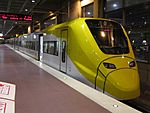 |
1999 | 7 | 4 | Pantograph | Used for the Arlanda Express service between Stockholm Central Station and Stockholm Arlanda Airport. |
| X40 |  |
2006–2008 | 43 | 2 or 3 | ||
| X60 X60A X60B |  |
|
129 | 6 | Used for commuter services. | |
| X61 | 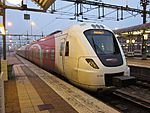 |
2009–present, multiple orders for multiple operators | 134 | 4 | Used for commuter and regional services. | |
| X62 | 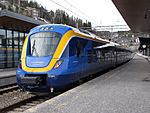 |
2012 | 11 | Used for the Norrtåg regional services in northern Sweden. These trains also have a bistro. |
United Kingdom
Coradia 1000
The first Coradia trains in Britain started service in 2001. This family includes two types. The diesel-powered Coradia 1000 family has the Class 175 (27 trains), which are currently not in use but are expected to re-enter service with GWR in 2025. It also includes the Class 180 Adelante (14 trains), which are high-speed trains. 12 of these are used by Grand Central.
Coradia Juniper
The electric Coradia Juniper family includes the Class 334 (40 trains used for Glasgow commuter services) and the Class 458 (30 trains used on routes from London Waterloo to Reading). The Class 460 trains, which were originally used for Gatwick Express airport services, were changed and added to the Class 458 fleet by early 2016.
| Class | Image | Operator | Introduced | Number | Carriages | End Gangways | Power | Notes |
|---|---|---|---|---|---|---|---|---|
| 175 |  |
Stored | 1999–2001 | 27 | 2 or 3 | No | Diesel | The two end cars are called A and C, even if there isn't a middle car B. Expected to re-enter service with GWR in 2025. |
| 180 |  |
Grand Central | 2000–2001 | (14 built, 12 in service) | 5 | |||
| 334 | 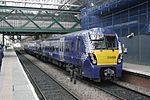 |
ScotRail | 1999–2002 | 40 | 3 | 25 kV 50 Hz AC / Pantograph | ||
| 458 (5-JUP) | 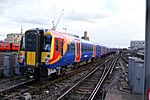 |
South Western Railway | 1998–2002 | 30 | 5 | Yes | 750 V DC / Contact shoe | Built as 4-car 458/0 for South West Trains, changed to 5-car 458/5 for South West Trains in 2012–2013. |
| 460 (8-GAT) | 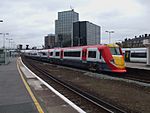 |
Gatwick Express | 1999–2001 | 8 | 8 | No | Taken out of service in 2012 and changed into Class 458/5 for South West Trains. |
North America
Canada
Canada was the first country in North America to use Coradia trains. OC Transpo in Ottawa started using six diesel Coradia LINTs on the O-Train Trillium Line in 2015. These trains replaced older ones. They have also been used on the airport branch line since 2025.
The private Charlevoix Railway in Québec briefly used hydrogen-powered iLINT trains for a demonstration in the summer of 2023.
United States
Metra is buying 200 double-decker Coradia passenger cars. They also have the option to buy 300 more. Virginia Railway Express, which worked with Metra on this purchase, is buying 21 double-decker Coradia cars. They also have an option for more cars.
Africa
Algeria
In 2018, Coradia trains began operating in Algeria. The SNTF bought 17 trains for long trips between cities like Algiers and Oran. The company also plans to use Coradia trains for other routes. SNTF named this project "Coradia ELDJAZAÏR".
Senegal
Alstom started delivering fifteen four-car Coradia Polyvalent train sets to Senegal in late 2018. These trains are used for the Train Express Regional service between Dakar and the Blaise Diagne International Airport.
Accidents and Incidents
- On July 12, 2016, an Alstom Coradia train was involved in a serious head-on collision in Andria, Italy. Sadly, many people were injured or lost their lives in this accident.
- On October 16, 2020, a Dutch ICNG train was being moved from Poland to the Netherlands when it derailed in Dreileben, Germany. The driver of the locomotive pulling the train was injured.
Images for kids
See also
 In Spanish: Alstom Coradia para niños
In Spanish: Alstom Coradia para niños


